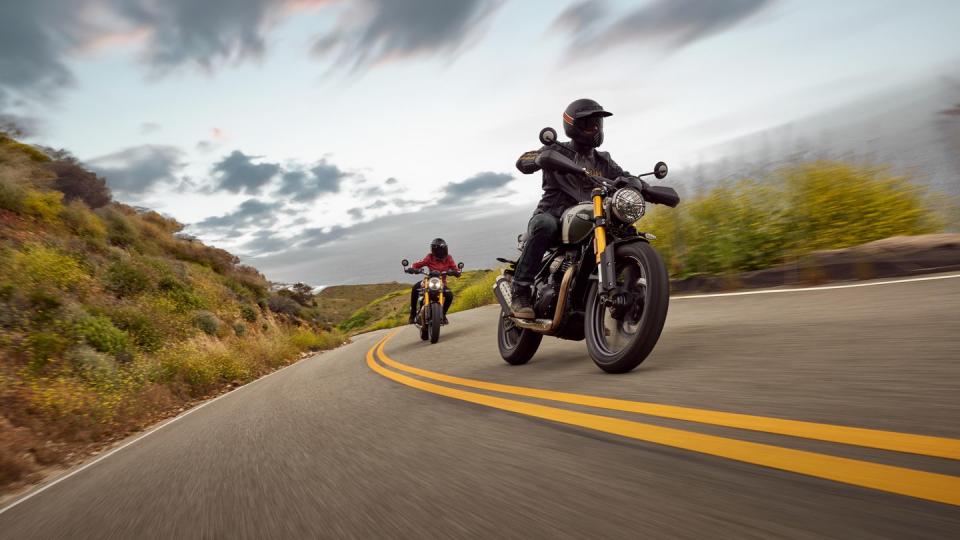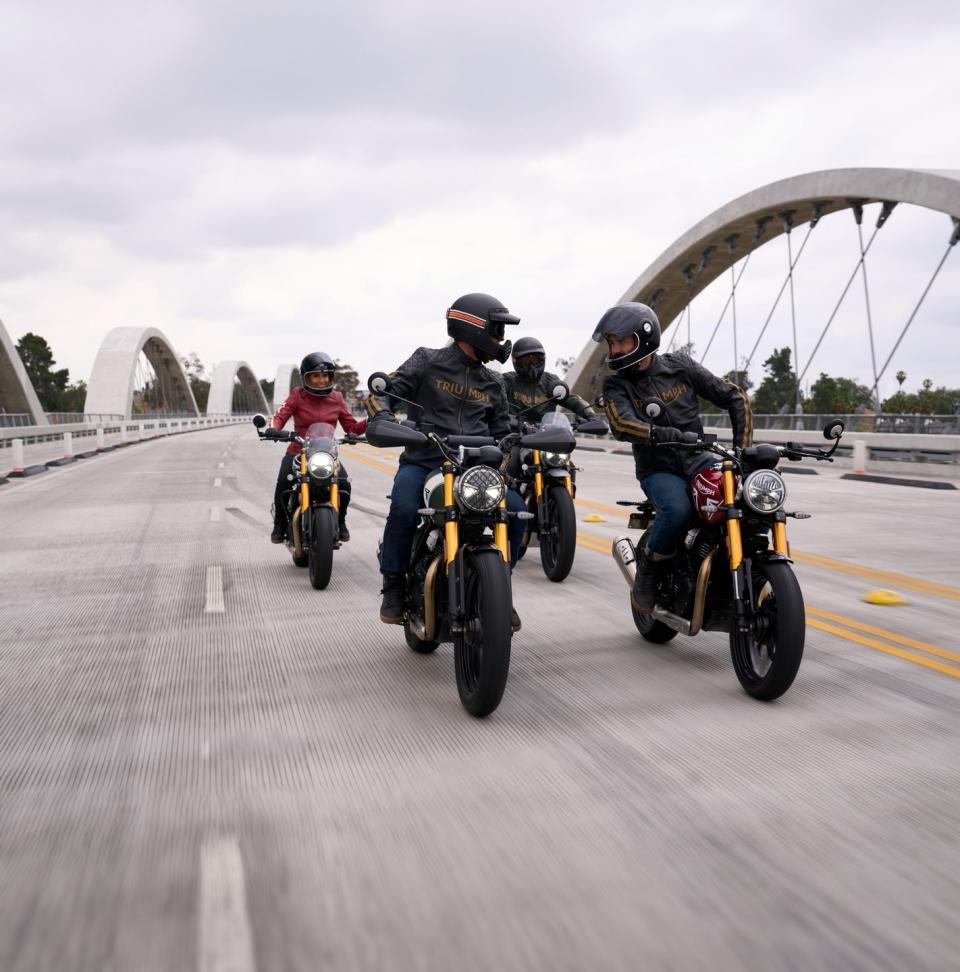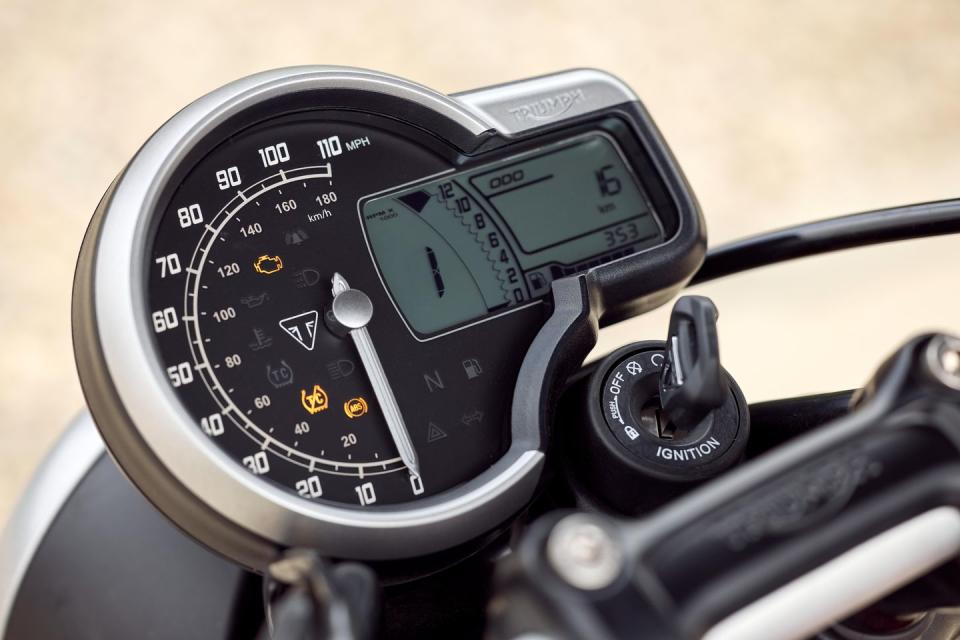Triumph Speed 400 Is Fast Fun on Only 400 CCs of Power

Triumph introduces a cool new entry-level motorcycle: the Speed 400.
Pricing starts at $4,995 before delivery.
The 400-cc powerplant is good for city scooting, less so for higher speed riding. Curb weight is 375 pounds wet, so it's lightweight.
Triumph is an icon among motorcycle manufacturers. Steve McQueen rode them in On Any Sunday and used a TR6 (via Bud Ekins) to jump the barbed wire fence in The Great Escape, as well as to compete in the International Six-Day Trials.
Clint Eastwood rode a TR6 in the movie Coogan’s Bluff. Elvis had one; Bob Dylan rode a T100 for years; Warren Beatty rode a Tiger 100 in Shampoo; and even Marlon Brando rode a Triumph Thunderbird 6T in The Wild One (no, it wasn’t a Harley!).
And yet, the cheapest Triumph anyone could get in recent years was a Tiger Sport 660 for $9,695. Well, not anymore. Last year, Triumph introduced the Speed 400, and coolness became available to the masses.
With all the looks of a classic Bonneville but at half the price at just $4,995, it is the entry-level bike for anyone who wants to get into motorcycling and look cool doing it.
The Triumph Scrambler 400X and Speed 400 are aimed at capturing new riders just as they enter the market. Get ‘em when they’re young and you may have a Triumph rider for life.
Both bikes are all-new, including the frames and engines. They were designed and engineered by Triumph and an Indian company called Bajaj, which is India’s third-largest motorcycle maker. India knows motorcycles, too, with a market that can exceed 20 million units in a year. Bajaj also developed and manufactures KTM’s sub-400cc motorcycles, so the KTM 390 Duke, a competitor, comes from them.

The 398cc upright single-cylinder engine comes with fuel injection, liquid-cooling, and dual-overhead cams operating all four valves via a finger-follower valvetrain. Triumph says the single has a low reciprocating mass and DLC coatings to reduce friction. A Bosch ride-by-wire throttle controls output of 39.5 hp at 8,000 rpm and 27.7 lb-ft of torque at 6,500 revs.
Triumph promises “…capacity defying performance” from this “free-revving yet tractable engine.” While it’s liquid-cooled, it wouldn’t be a Triumph without those cooling fins on the block.
It rides on that new frame with a bolt-on rear subframe and cast-aluminum double-sided swing arm. Seat height on the Speed 400 is 31 inches. A single 400mm disc stops the front 17-inch wheel while another single 230mm disc stops the rear. In front are 43mm upside down Big Piston forks that provide 140mm of wheel travel. In back is a gas monoshock RSU with external reservoir and pre-load adjustment. It gives 130mm of wheel travel.
So the specs sound right—there’s nothing missing.
And indeed, as soon as you lift the Speed 400 off its kickstand, the 375-pound (wet weight with all the fluids) feels light and easy to toss around. Fire the electric starter and you say a silent thank you to Bosch, but only if you grew up kick-starting carbureted bikes.
The clutch action is very easy to operate and the gears go right into place without ambiguity or false neutrals. Immediately you feel at ease and at home on this motorcycle. A beginner would feel unintimidated (assuming they know how to shift the six-speed manual, of course).
Out on the road you start thinking, “A new motorcycle is so much better than that ancient wheezer I rode down here.” But then you notice the extremely short power band. You have to shift up and down a lot to get anywhere, which isn’t a problem since the shifter is so well-engineered. It’s just unexpected.

I’ve never encountered such a narrow power band on any other bike, including competitors like the Honda CB300R, Kawasaki Z400, Yamaha MT-03, and KTM 390 Duke, the predecessors to which I’ve ridden a few years ago.
On the freeway you’re out of revs at the top of sixth gear trying to keep up with the 80-mph freeway traffic. It keeps up just fine, but above about 6,500 rpm the tach starts flashing at you to slow down—80 mph was about as fast as felt appropriate for the rig.
Squirting through holes in city traffic in downtown LA or in Mumbai, India, where this is made, it fits in better than flat-out on an empty highway. Top speed is 90 mph, but some riders have posted speeds of just under 105. I did not want to abuse the bike, though peak power is listed at 8,000 rpm and redline is 9,500 (the tach optimistically goes to 12,000).
Because of the limited speed and busy shifting, I didn’t ride it as much as I could have, but a beginning rider or one returning to the sport after some time away will feel perfectly at ease on this. I would highly recommend a Speed 400 to anyone just starting out. Within its parameters it is superb.
Its sticker price of $4,995 is in line with the competition, though with all of them you have to add between $500 and $700 for destination. The Honda CB300R is another single-cylinder that weighs just 316 pounds wet and costs $5,149. The Kawasaki Z400 is an upright parallel twin that is smooth and revs higher without complaint for $5,399.
And I spent a very fun day riding the Yamaha MT-03 around the hills outside Austin, Texas, when that bike came out. It’s another higher-revving upright parallel twin that stickers for $4,999. And don’t forget the Duke—the KTM 390 is made by the same company as the Triumph and has a class-topping 44 hp for $5,899.
There are a lot of good, fun, entry-level motorcycles out there. Try ‘em all. But if you’re looking for style, easy shifting, and fun city threading, the Triumph may triumph.
Is 400 CCs enough, or do you need more? Let us know below.

 Yahoo Autos
Yahoo Autos 